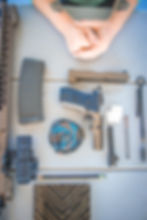Why, when and how to clean your firearm.
- Alexandra Vonhindenfalken
- Jul 12, 2023
- 4 min read
Updated: Jul 14, 2023
W H Y:

As an Armorer in the Marine Corps, the first thing that I would ask a Marine who has brought me their weapon after it malfunctioned was: “When was the last time you cleaned it?” They hate this question, but the truth is: A dirty gun is an unreliable gun. So, I’d throw some cleaning gear at them and once their gun was clean, 80% of the time, it would go back to running smoothly. The rest of the time it was a broken magazine or something else, but that’s a topic for a different post.
We have our firearms for a reason. Whether it be self-defense, hunting, sport shooting or as a collection, their usefulness and value diminishes if they are dirty. If we find ourselves in a self defense situation, a malfunction could be the difference between life and death for you or someone that you may be protecting. If you are hunting, a malfunction could ruin that one chance that you get, and the same with precision sport shooting.
If a firearm is left dirty/fouled for an extended period it could lead to corrosion inside of the barrel which affects the accuracy of your shots. The inside and outside of the firearm can rust over time in humid environments, which can be prevented by cleaning regularly. Rust is a firearm’s worst enemy (besides a dictatorship… but we won’t go there right now). If you see rust anywhere on your firearm, it is a sign that it is time to give it a good cleaning.
Lastly, cleaning your firearm is a good way to become more acquainted with how it works. For some people cleaning is an enjoyable part of gun ownership. Personally, I like cleaning my guns, I usually put on a show that I am currently binging (right now it is Mindhunter… its so good!!!) and settle in.

W H E N
The answer to this depends on a few factors:
How often it is used on the range, how many rounds and what type of ammo has been put through it, and if it has been exposed to water, sweat or dirt.
If you use your guns for shooting practice on the range or occasional firearm safety courses, cleaning them after every 500 rounds is a safe bet. If you are a “once in a while” shooter and make time for the range once every few months, then cleaning them after each trip is best. This will clean off any carbon build-up from that day’s practice and prevent any rusting between range trips.
If you use your firearms outside where there is dirt and humidity, you should clean them a bit more often. In Texas, the spring hangs around for about .02 seconds before summer comes barreling in full-force to test everyone’s fortitude. If you are conceal carrying in the summer, you are almost certainly going to get sweat on your firearm. With sweat comes rust… and if you remember, rust is a firearms worst enemy. A light coat of CLP (see tomorrows post) will help prevent that. If you see rust, wipe/scrape it off and give all the metal parts that nice light coat of CLP. This goes for your magazines too if they are made of metal. If you’ve been diligent about practicing your speed reloads, and drop your magazines in the dirt, you’ll want to take them apart and clean them as well. “Bad” magazines are a major cause for weapons malfunctions.
If you use ammo that has corrosive properties, such as military surplus ammo, you should clean your firearm after every single use. This type of ammo is typically used in older historical firearms that were used in WW2 and before. Most modern ammunition is non-corrosive.
H O W
How to disassemble and clean a firearm is one of the most common topics that I get asked to cover during private lessons for new firearm owners. I find that most new firearm owners are not aware that their firearm comes with an owner’s manual, and if they do… it’s pretty overwhelming. Especially if you don’t already speak the gun “language”. If I weren’t already an Armorer, I would have no clue what a “striker” or a “barrel lug” or a “follower” is. If there is a follower is there a leader?
To find out how to clean your firearm, consult your owner’s manual. If you don’t have one, look it up online. Almost all firearm manufacturers will have a PDF version of their owner’s manual online, the link above will take you to all of Sig Sauers online PDF versions. Choose the "Pistols" tab, click any random manual, then scroll down until you see the table of contents. The owner’s manual will tell you how to take your firearm apart step by step, how to clean it and where to lubricate it and what to use, then how to put it back together and check to make sure that you put it back together correctly (this is called a “functions check”).
If following the directions in the owner’s manual proves to be too frustrating, turning to YouTube to find a tutorial is the next best step. There is an infinite number of firearm disassembly/reassembly videos out there, both professionally made and ones that seem to be made in the dirtiest depths of someone’s back-woods basement! Always go for the videos that are made by the manufacturer of your firearm.
Lastly, I will leave you with some tricks of the trade:
Household Q-tips are just as useful as the ones sold specifically for use in firearms and are much cheaper.
You can wrap a cleaning patch with CLP on it around your bore brush to clean and scrape off carbon at the same time as you push/pull it through the barrel.
A little CLP goes a LONG way, just a few drops on an old rag can cover all the necessary metal parts just fine after you are done cleaning.
An old microfiber rag with some CLP on it is just as useful as a $15 “gun cleaning cloth”.
Always wipe way old lubricant that is left over from the last cleaning, it has dust and carbon and debris mixed in with it.
If cleaning your firearm feels like it is still an overwhelming and untouchable mystery, please get in contact! I would be happy to walk you through it in person and give you a hands-on experience for something that SHOULD be taught in a hands-on setting.






















